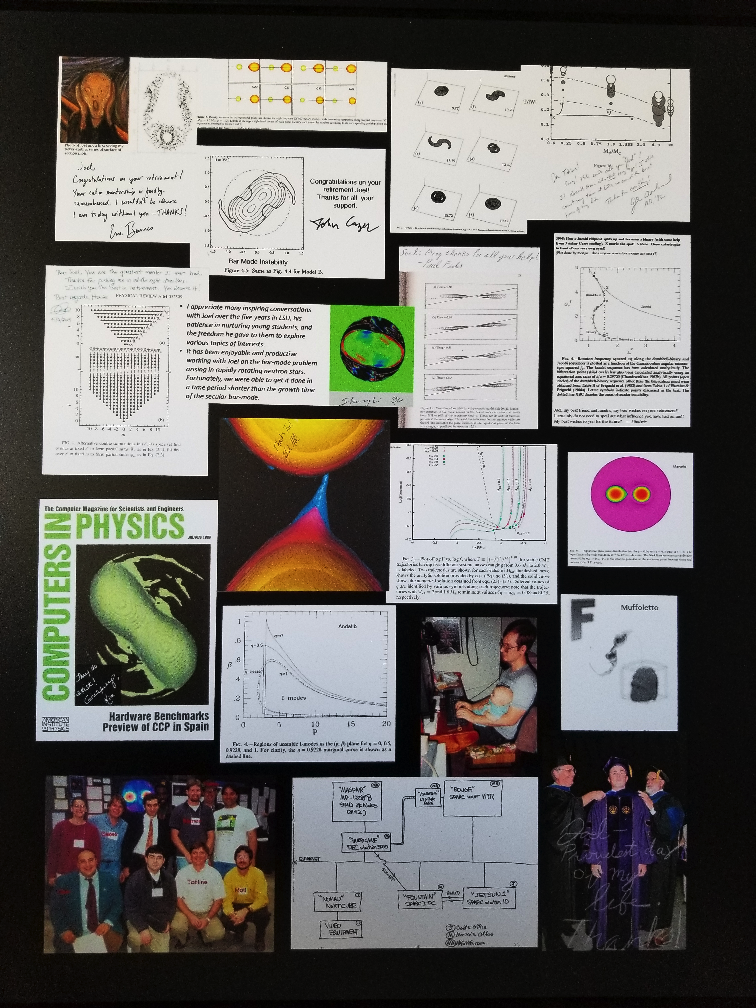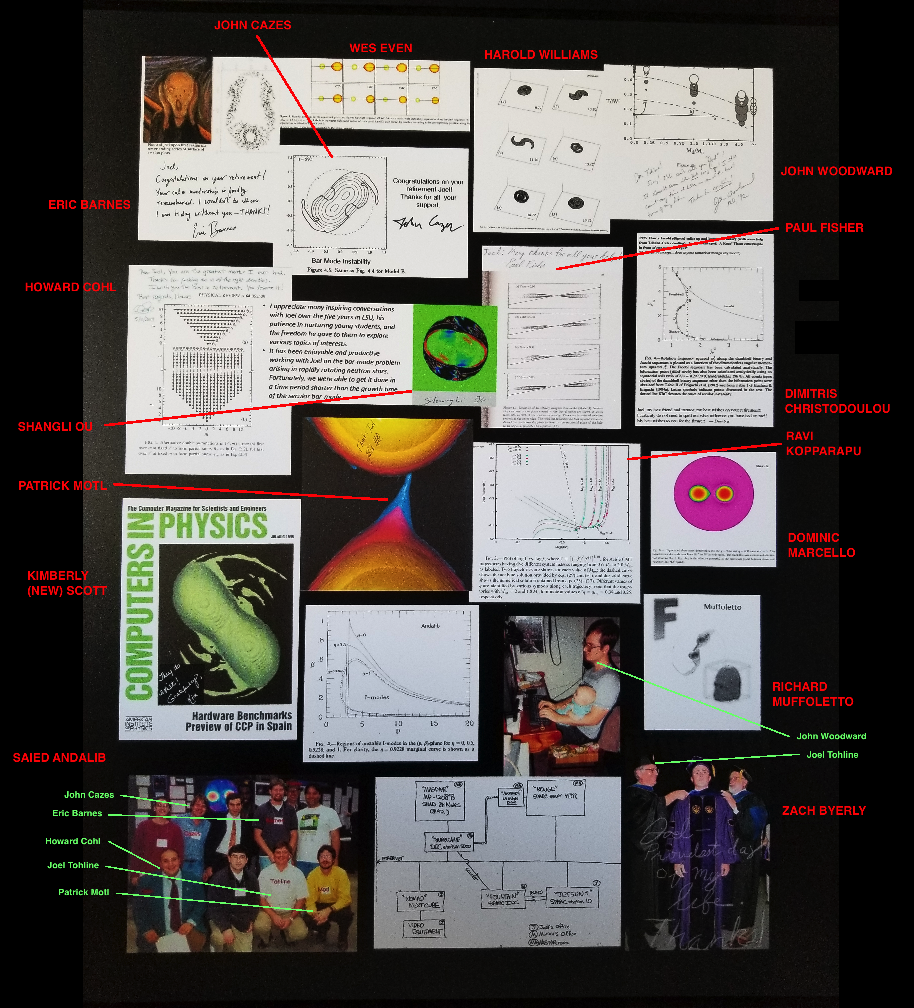User:Tohline/Appendix/Ramblings/MyDoctoralStudents
Chronology of Research Endeavors

|
|---|
| | Tiled Menu | Tables of Content | Banner Video | Tohline Home Page | |
Preface
Looking back, it seems clear to me that the technical book that has had the most influence on my research career has been [EFE], that is, Chandrasekhar's (originally, 1969) Ellipsoidal Figures of Equilibrium. Chandrasekhar evaluated the relative stability of a wide variety of astrophysically interesting (usually Newtonian self-gravitating), rotating equilibrium configurations by employing his own exceptional mathematical skills and those of his students — notably, Norman Lebovitz. When I entered graduate school at UC, Santa Cruz in 1974, [EFE] was the set of glasses through which most astronomers examined stability. Having access to only meager computing resources, Chandrasekhar's descriptions of the onset of instabilities, or evolution between nearly adjacent states, was usually limited to linear-amplitude deviations from equilibrium. From the beginning, I have been interested in using (steadily improving) computational resources to repeat, then extend the analyses found in [EFE] … (1) to configurations with non-homogeneous and compressible structures; and (2) into the nonlinear regime.
The MediaWiki-formatted text that you are reading — titled, The Structure, Stability, & Dynamics of Self-Gravitating Fluids — is my attempt to explain in detail what has been learned as a result of our (and the broader astrophysics community's) extension of the foundation work presented in [EFE]. The chapters of this ever-developing book that, on any date, I consider ready for public consumption can be found on the MediaWiki page that I refer to as the Tiled Menu. The graduate students who have come through my group over the years have made important contributions to the healthy development of this research field. The Outline of Research Activities that is presented, below, highlights and summarizes these contributions.
Doctoral Students Tohline Has Advised
| Doctoral Students Whom Tohline has Advised at LSU | |||||||
|---|---|---|---|---|---|---|---|
| Year of Ph.D. | Student Name | ED† | Jointly Advised? |  |
|||
| 1988 | Harold Williams | ||||||
| 1989 | Dimitris M. Christodoulou | ||||||
| 1992 | John Woodward | ||||||
| 1994 | Horst Väth | w/ Detlev Koester (Univ. of Kiel, Germany) | |||||
| 1996 | Kimberly C. (Barker) New | ||||||
| 1998 | Paul Fisher | ||||||
| 1998 | Saied Andalib | ||||||
| 1998 | Erik Young | w/ Ganesh Chanmugam (LSU Physics & Astronomy) | |||||
| 1999 | John E. Cazes | ||||||
| 1999 | Howard S. Cohl | ||||||
| 2001 | Eric I. Barnes | ||||||
| 2001 | Patrick M. Motl | <math>~\odot</math> | w/ Juhan Frank (LSU Physics & Astronomy) | ||||
| 2004 | Shangli Ou | <math>~\odot</math> | |||||
| 2006 | Ravi Kumar Kopparapu | <math>~\odot</math> | |||||
| 2006 | Richard P. Muffoletto | <math>~\odot</math> | w/ John Tyler (LSU Computer Science) | ||||
| 2010 | Wes P. Even | <math>~\odot</math> | |||||
| 2010 | Jay M. Call | <math>~\odot</math> | |||||
| 2011 | Dominic C. Marcello | <math>~\odot</math> | |||||
| 2014 | Zachary D. Byerly | <math>~\odot</math> | |||||
|
|||||||
Outline of Research Activities
| Years (approx.) | Comments | Significant Research Contributions‡ | Discussion | |||
|---|---|---|---|---|---|---|
| A | CH | V | O | |||
| 1976 - 1978 |
Tohline's dissertation research under the guidance of Peter Bodenheimer (UCSC) and David Black (NASA/Ames) was an early attempt to examine whether of not isothermal gas clouds whose mass exceeds the Jeans mass spontaneously fragment during a phase of free-fall collapse. The adopted Eulerian computational hydrodynamics scheme was first-order donor-cell based on the 2D (axisymmetric, cylindrical-coordinate) scheme described by Black & Bodenheimer (1976) but extended by Tohline to a 3D grid; a typical simulation was carried out on the CDC7600 at NASA/Ames and involved <math>~30^3 \approx 3 \times 10^4</math> grid cells. The self-consistently determined, time-dependent Newtonian gravitational potential was determined by combining (1) an FFT technique in the azimuthal coordinate direction, with (2) a Buneman Cyclic Reduction technique in R and Z. Richard Durisen — a NASA/Ames postdoc at the time — said to me something along the lines of, "Hey! When you finish developing that hydrocode, let's get together and examine the dynamical stability of rapidly rotating, equilibrium configurations." |
sf | ♦ | -- | -- | TBD |
| 1978 - 1982 |
While at Yale University (1978 - 1980) and at Los Alamos National Laboratory (1980 - 1982), Tohline worked closely with Richard Durisen (Indiana University) to examine the onset and nonlinear development of nonaxisymmetric instabilities in differentially rotating, n = 3/2 polytropes whose internal angular momentum distribution was that of an n' = 0 sequence. Generally speaking, unstable eigenfrequencies matched earlier predictions (by other groups) based on linear stability analyses; unstable eigenfunctions displayed a two-armed spiral character. As the amplitude of unstable modes grew to nonlinear amplitude, the developed spiral arms were able to effectively redistribution angular momentum, preventing fragmentation/fission of the configurations. Nelson Caldwell — a Yale graduate student at the time — showed Tohline some of his early work focused on the observationally determined properties of elliptical galaxies that display prominent dust lanes. Additional discussions led to a collaboration between Caldwell, Tohline, and Gregory Simonson — also a Yale graduate student at the time — in which the observed orientation of dust lanes can be explained in terms of dissipative settling of gas disks and, as a consequence, can be used to deduce the underlying geometry (e.g., oblate or prolate spheroidal) of each galaxy's mass distribution. With guidance from Tohline, Simonson completed a Yale University doctoral dissertation in which this settling model was extended to the context of polar rings in spiral galaxies. When Tohline presented a seminar in the Department of Astronomy at Indiana University on the topic of "dust lanes in elliptical galaxies," Durisen asked what would happen to a settling gas disk if the underlying galaxy mass distribution was tumbling end over end — e.g., a cigar spinning about its shortest axis. The ensuing discussions led to a fruitful collaboration between Durisen and Tohline in which it became clear that steady-state warped disks could result. (After Tohline moved to LSU, extensions of this research work resulted in collaborative publications with several LSU graduate students — D. Christodoulou, K. New, H. Väth — and in Paul Fisher's doctoral dissertation research project.) |
sf, gd | -- | -- | -- | TBD |
| ‡Research areas in which significant contributions were made: Astrophysics (A), Computational Hydrodynamics (CH), Visualization (V), and Other (O). Subcategories under Astrophysics are sf (star formation), gd (galaxy dynamics), GR (sources of gravitational radiation). | ||||||

|
|---|
|
© 2014 - 2021 by Joel E. Tohline |
